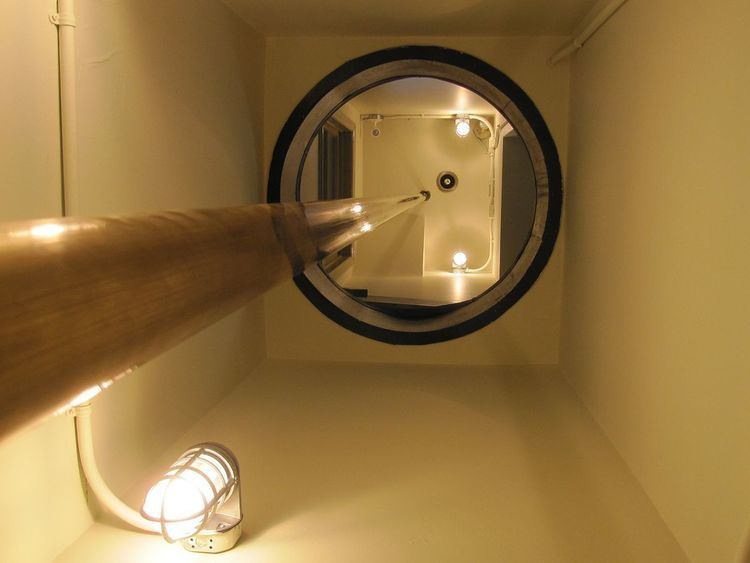 | ||
A fireman's pole (also called a sliding pole, firepole, or tom) is a wooden pole or a metal tube or pipe installed between floors in fire stations, allowing firefighters responding to an alarm to quickly descend to the ground floor faster than by using a standard staircase.
Contents
The device was invented in the 1870s by David Kenyon, in Chicago, Illinois, although it is often incorrectly credited to the Boston Fire Department.
Overview
Firefighters usually remain above the ground floor of fire stations until they receive a call for help, after which they descend, don their firefighting gear, and board the fire engine as quickly as possible. Until 1878, spiral staircases or sliding chutes were common, but not particularly fast. Fire houses were also equipped with spiral staircases so the horses would not try to climb the stairs into the living quarters. The fireman's pole allows firefighters to move down much more quickly, although it is not suitable for climbing up. The pole connects the ground floor to the ceiling of the floor above through a hole in the ground floor ceiling. To use a pole, a firefighter puts their arms around it, steps into the hole, and uses their legs to control the speed of the descent, somewhat similarly to the technique used for fast-roping.
History
Capt. David B. Kenyon of Chicago's Engine Company No. 21 (an all-black engine company) worked in a three-story fire station; the ground floor containing the firefighting equipment, the floor above being the floor for recreation and sleeping, and the top floor being the hayloft which was used to store the winter supply of hay for the fire engines' horses. During transport, the hay was secured to a wagon using a wooden binding pole, which was stored in the hayloft when not in use. Firefighter George Reid slid down the pole to respond to a call for help once, which inspired Captain David Kenyon to create a permanent pole.
In 1878 he convinced the Chief of Department to make the necessary hole in the building and install the pole, after agreeing to pay for any necessary maintenance. The Company crafted a pole out of a Georgia pine beam by shaving and sanding it into a 3" diameter pole which they gave several coats of varnish and a coat of paraffin.
After being the target of many jokes, people realized Company 21 was usually the first company to arrive when called, especially at night, and the Chief of Department ordered the poles to be installed in all Chicago fire stations. In 1880 the first brass pole was installed in the Boston Fire Department.
Safety issues
Losing one's grip on the pole can result in falling from a great height; the firefighter may hit an object such as a door extending from a truck; poor speed control can result in injured or even broken legs upon impact with the floor; and burns can occur due to friction against the pole.
Slide poles can be made safer. Cushions can be placed around the base of the pole to soften landings. Other safety features include railings, baskets or closets that surround part of the opening, weight-activated doors that open only when weight is applied to the pole to prevent accidental falls, and exhaust control systems that prevent fumes from the apparatus bay from coming into the living quarters.
Despite the strong tradition and time advantage of slide poles, the National Fire Protection Association has called for the removal of all poles from US fire stations due to safety hazards. Many cities have removed poles from their stations, but some new multilevel fire stations include slide poles with appropriate safety features.
The policy of the New Zealand Fire Service is that existing fire poles not be used and that no newly constructed stations shall have them. As a result, most new fire stations are designed and built on a single level. In some older stations, particularly historic ones built on three levels, firefighters on the top floor will still use the pole because of the significant delay associated with taking the stairs.
Some American Fire Services are seeking to improve the safety of the fire pole system itself. Products such as "A Better Fire Pole Mat" are claiming that injuries can be reduced if they use commercial grade impact attenuation systems.
Other uses
Firepoles are seen in popular films, including Ghostbusters and Bridget Jones's Diary feature, and in the Batman 1960s TV series, where they appear in Batman's Wayne Manor as access to the Batcave below. In the Korean sitcom High Kick!, Lee Min Yong's room is connected with the rest of the house by a fireman's pole.
In Season One of the Disney Channel television series JONAS, the Lucas family lives in a converted fire station in New Jersey, complete with three firepoles that connect the studio space of Kevin, Joe, and Nick Lucas (the fictional band JONAS) with the family space on a lower level of the house.
Some airbases in Germany were also equipped with firemen's poles to expedite travel from the second-floor ready rooms to their aircraft in the event of a scramble. The military and law enforcement tactical teams also use a similar sliding descent, known as fast-roping, to quickly descend from helicopters on large-diameter ropes. Gloves must be worn to prevent friction burns.
Firemen's poles are also major gameplay elements in such video games as Montezuma's Revenge and the second Commander Keen trilogy.
